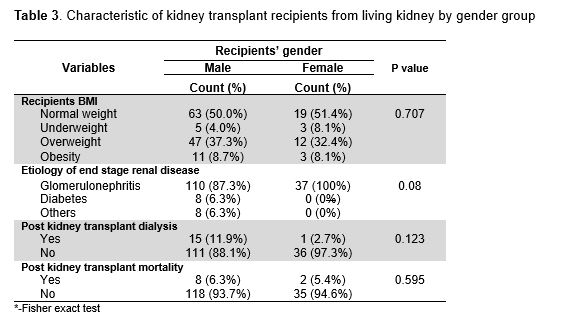
Gender disparity in kidney transplantation in Mongolia an analysis of the ASTREG WIT KT registry
Lkhaakhuu Od-erdene1, Tseren Ts Khishgee1, Davaadorj D Bayan-Undur1, Batsuuri B Batsaikhan1, Batchulun B Tumurbaatar1, Dondog D Javkhlantugus1.
1Organ transplantation center, First central hospital of Mongolia, Ulaanbaatar, Mongolia
ASTREG WIT KT.
Introduction: Gender inequality and socioeconomic status in Mongolia are different and unique. We conducted a retrospective study from 2015 to 2022, a total of 198 patients who received living kidney transplants participated in this study.
Method: We determined donor to recipient gender match as following groups: 1st group: male donor to male recipient /M-M/, 2d group: male donor to female recipient /M-F/, 3th group: female donor to female recipient /F-F/ and 4th group: female donor to man recipient /F-M/. Analyzed the graft and the patient's 1- and 3-years survival rate. All analyses were performed using STATA 17. Graft and patients survival were evaluated using Cox proportional hazards regression with adjustment for the following confounders: gender, donor and recipient age, recipient body mass index, HLA B and HLA-DR combined mismatch, diagnosis, dialysis, and year of first kidney transplant. We determined 3-year patients and graft survival.
Result: Respectively, mothers was more donated her kidney to child than other groups. The majority of living kidney donors were female, with over 8 (40.0%) patients with the parental relationship were mother and 3 (17.6%) patients were from fathers. On the other hand, in male recipients, 9 (52.9%) recipients received from sisters and 31 (47,7%) recipients received from brothers (P>0.05). In terms of donor employment and religion, there was no statistically significant difference among gender groups. In all gender groups, except F-F group, overweight donor consisted more than half of total donors (P>0.05). Men were more likely to have diabetes than women (P>0.05). 11.9% (15) of male recipients underwent RRT, whereas, 2.7% (1) of female recipients had RRT (P>0.05). During the study period, 6.3% (8) of male recipients passed away, which is slightly higher percent than female group (P>0.05).

Regarding HLA typing miss much by 6 locus, 38.7% (63) of total recipients had 3 locules miss much. In all gender groups, majority percent of HLA typing was 6-3 locus, but, in F-F group, 6-3 locus HLA matching was higher than other groups (P=0.002).

1- and 3- year graft survival rate was 99.4% and 93.9%, respectively. We found that female recipients of male donor were nonsignificant higher graft survival rate (P>0.05)
Conclusion: Relationship analysis was more likely donation siblings, but gender differences in male donor was higher than woman donors. This result was different of results most of another countries. What reason of this differences we can give some hypothesis, such as most of man donors (52.1%) was from countryside’s farmers with low education and low economic status. Another hypothesis of man donors (58.3%) on the non-religion status. Women are more likely to become a living donor than they are to receive a living donor kidney donation. The graft survival advantage was in group female recipients of male donor kidneys.
Aiming to understand the culprits for gender inequities in access to transplantation, established an online database, ASTREG-WIT-KT to study contemporary gender-specific geographical differences in transplantation and organ donation preceding the coronavirus disease 2019 pandemic. Participation in this program will be important to understand gender disparity in kidney transplantation in Mongolia and comparison our result with another Asian countries.
[1] gender disparity
[2] living kidney donor
[3] Mongolia
[4] kidney transplantation
[5] ASTREG
[6] WIT
